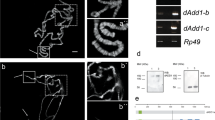Abstract
Eu-heterochromatic rearrangements transfer genes into the heterochromatin and cause their variegated inactivation (PEV). Genes affected by PEV often demonstrate association with heterochromatic nuclear compartment (a distinct area composed of heterochromatin sequences like satellite DNA and enriched in specific chromatin proteins, e.g., HP1). Here, we investigate the nuclear localization and the expression levels of the genes subjected to PEV caused by chromosome inversion, In(2)A4. We demonstrate that the degree of PEV-caused gene inactivation depends on a developmental stage, and the maximum of repression corresponds to the gene expression activation period. In the case of In(2)A4 rearrangement, we detect the dragging of the affected euchromatin region into the nuclear compartment of heterochromatin and the increase in HP1 occupancy in this region. We developed a protocol for simultaneous RNA-DNA-protein staining in order to demonstrate the strong correlation between the transcriptional activity of the affected gene and its distance from chromosome 2 satellite DNA in a single cell.
Similar content being viewed by others
References
Girton J.R. Johansen K.M. 2008. Chromatin structure and the regulation of gene expression: The lessons of PEV in Drosophila. Adv. Genet. 61, 1–43.
Vogel M.J., Pagie L., Talhout W., Nieuwland M., Kerkhoven R.M., van Steensel B. 2009. High-resolution mapping of heterochromatin redistribution in a Drosophila position-effect variegation model. Epigenetics Chromatin. 2(1), 1.
Harmon B., Sedat J. 2005. Cell-by-cell dissection of gene expression and chromosomal interactions reveals consequences of nuclear reorganization. PLoS Biol. 3(3), e67.
Csink A.K., Bounoutas A., Griffith M.L., Sabl J.F., Sage B.T. 2002. Differential gene silencing by transheterochromatin in Drosophila melanogaster. Genetics. 160(1), 257–269.
Abramov Y.A., Kibanov M.V., Gvozdev V.A., Lavrov S.A. 2011. Genetic and molecular analysis of gene trans-inactivation caused by homologous eu-heterochromatic chromosome rearrangement in Drosophila melanogaster. Dokl. Biochem. Biophys. 437, 72–76.
Tulin A.V., Naumova N.M., Aravin A.A., Gvozdev V.A. 1998. Repeated, protein-encoding heterochromatic genes cause inactivation of a juxtaposed euchromatic gene. FEBS Lett. 425(3), 513–516.
Chao J., Debiasio R., Zhu Z., Giuliano K.A., Schmidt B.F. 1996. Immunofluorescence signal amplification by the enzyme-catalyzed deposition of a fluorescent reporter substrate (CARD). Cytometry. 23(1), 48–53.
Hunyady B., Krempels K., Harta G., Mezey E. 1996. Immunohistochemical signal amplification by catalyzed reporter deposition and its application in double immunostaining. J. Histochem. Cytochem. 44(12), 1353–1362.
Bobrow M.N., Harris T.D., Shaughnessy K.J., Litt G.J. 1989. Catalyzed reporter deposition, a novel method of signal amplification: Application to immunoassays. J. Immunol. Methods. 125(1–2), 279–285.
Csink A.K., Henikoff S. 1996. Genetic modification of heterochromatic association and nuclear organization in Drosophila. Nature. 381(6582), 529–531.
Dernburg A.F., Broman K.W., Fung J.C., Marshall W.F., Philips J., Agard D.A., Sedat J.W. 1996. Perturbation of nuclear architecture by long-distance chromosome interactions. Cell. 85(5), 745–759.
Author information
Authors and Affiliations
Corresponding author
Additional information
Original Russian Text © S.A. Lavrov, A.S. Shatskikh, M.V. Kibanov, V.A. Gvozdev, 2013, published in Molekulyarnaya Biologiya, 2013, Vol. 47, No. 2, pp. 286–291.
Rights and permissions
About this article
Cite this article
Lavrov, S.A., Shatskikh, A.S., Kibanov, M.V. et al. Correlation between cellular level of gene transcriptional silencing and heterochromatin compartment dragging in case of PEV-producing eu-heterochromatin rearrangement in Drosophila melanogaster . Mol Biol 47, 252–258 (2013). https://doi.org/10.1134/S0026893313020088
Received:
Accepted:
Published:
Issue Date:
DOI: https://doi.org/10.1134/S0026893313020088




